Welfare Assessment and Identification of the Associated Risk Factors Compromising the Welfare of Working Donkeys (Equus asinus) in Egyptian Brick Kilns
Simple Summary
Abstract
1. Introduction
2. Materials and Methods
2.1. Study Area
2.2. Behavior Parameter Examination
2.3. Physical Health Parameter Examination
2.4. Physical Environmental Parameters Assessment
2.5. Statistical Analysis
3. Results
3.1. Physical Health Parameters
3.2. Behavioral Parameter Assesment
3.3. Physical Environmental Parameters
4. Discussion
5. Conclusions
Author Contributions
Funding
Acknowledgments
Conflicts of Interest
References
- Blakeway, J.S. The Welfare of Donkeys. MSc Thesis, University of Edinburgh, Edinburgh, UK, 1994. [Google Scholar]
- Leeb, C.; Henstridge, C.; Dewhurst, K.; Bazeley, K. Welfare assessment of working donkeys: Assessment of the impact of an animal health care project in West Kenya. Anim. Welf. 2003, 12, 689–694. [Google Scholar]
- Pritchard, J.C.; Lindberg, A.C.; Main, D.C.J.; Whay, H.R. Assessment of the welfare of working horses, mules and donkeys, using health and behaviour parameters. Prev. Vet. Med. 2005, 69, 265–283. [Google Scholar] [CrossRef]
- Burn, C.C.; Denison, T.L.; Whay, H.R. Relationships between behaviour and health in working horses, donkeys, and mules in developing countries. Appl. Anim. Behav. Sci. 2010, 126, 109–118. [Google Scholar] [CrossRef]
- Burn, C.C.; Dennison, T.L.; Whay, H.R. Environmental and demographic risk factors for poor welfare in working horses, donkeys and mules in developing countries. Vet. J. 2010, 186, 385–392. [Google Scholar] [CrossRef]
- Saul, C.; Siefert, L.; Opuda-Asibo, J. Disease and health problems of donkeys: A case study from eastern Uganda. In Improving Donkey Utilization and Management, Proceedings of the Animal Traction Network for Eastern and Southern Africa Workshop, Debre Zeit, Ethiopia, 5–9 May 1997; Starkey, P., Ed.; Animal Traction Development: Oxgate, UK, 1998; pp. 58–63. [Google Scholar]
- de Aluja, A.S. The welfare of working equids in Mexico. Appl. Anim. Behav. Sci. 1998, 59, 19–29. [Google Scholar] [CrossRef]
- Curran, M.; Feseha, G.; Smith, D. The impact of access to animal health services on donkey health and livelihoods in Ethiopia. Trop. Anim. Health Prod. 2005, 37, 47–65. [Google Scholar] [CrossRef]
- Tesfaye, A.; Curran, M.M. A longitudinal survey of market donkeys in Ethiopia. Trop. Anim. Health Prod. 2005, 37, 87–100. [Google Scholar] [CrossRef] [PubMed]
- Wells, D.; Krecek, R.C. Socioeconomic, health and management aspects of working donkeys in Moretele 1, North West Province, South Africa. J. S. Afr. Vet. Ass. 2001, 72, 37–43. [Google Scholar] [CrossRef] [PubMed]
- Oussat, M. Welfare assessment of working donkeys in Nouakchott (Mauritania). In Fifth International Colloquium on Working Equines the Future for Working Equines, Addis Ababa, Ethiopia, 30 October–2 November 2006; Pearson, A., Muir, C., Farrow, M., Eds.; The Donkey Sanctuary: Sidmouth, UK, 2006; pp. 130–137. [Google Scholar]
- Pearson, R.A.; Krecek, R.C. Delivery of health and husbandry improvements to working animals in Africa. Trop. Anim. Health Prod. 2006, 38, 93–101. [Google Scholar] [CrossRef] [PubMed]
- Geiger, M.; Hovorka, A. Donkeys in development: Welfare assessments and knowledge mobilisation. Dev. Pract. 2015, 25, 1091–1104. [Google Scholar] [CrossRef]
- Popescu, S.; Diugan, E.A. The relationship between behavioral and other welfare indicators of working horses. J. Equine Vet. Sci. 2013, 33, 1–12. [Google Scholar] [CrossRef]
- Reix, C.E.; Burn, C.C.; Pritchard, J.C.; Barr, A.R.S.; Whay, H.R. The range and prevalence of clinical signs and conformation associated with lameness in working draught donkeys in Pakistan. Equine Vet. J. 2014, 46, 771–777. [Google Scholar] [CrossRef] [PubMed]
- Tadich, T.; Escobar, A.; Pearson, R.A. Husbandry and welfare aspects of urban draught horses in the south of Chile. Arch. Med. Vet. 2008, 40, 267–273. [Google Scholar] [CrossRef]
- Kay, G. On a mission: Caring for working equids abroad. In Pract. 2007, 29, 108–111. [Google Scholar] [CrossRef]
- Ali, A.B.; El Sayed, M.A.; Matoock, M.Y.; Fouad, M.A.; Heleski, C.R. Are mules or donkeys better adapted for Egyptian brick kiln work? (Until we can change the kilns). J. Vet. Behav. 2015, 10, 158–165. [Google Scholar] [CrossRef]
- Rossel, S.; Marshall, F.; Peters, J.; Pilgram, T.; Adams, M.D.; O’Connor, D. Domestication of the donkey: Timing, processes, and indicators. Proc. Natl. Acad. Sci. USA 2008, 105, 3715–3720. [Google Scholar] [CrossRef]
- Muylle, S. Aging. In Equine Dentistry, 3rd ed.; Easley, J., Dixon, P.M., Schumacher, J., Eds.; Elsevier: Edinburgh, Scotland, 2010; 424p, Available online: https://www.elsevier.com/books/equine-dentistry/easley/978-0-7020-2980-6 (accessed on 1 June 2020).
- Pearson, R.A.; Ouassat, M.A. Guide to Live Weight Estimation and Body Condition Scoring of Donkeys; University of Edinburgh, Centre for Tropical Veterinary Medicine: Edinburgh, Scotland, 2000. [Google Scholar]
- Svendsen, E.D. The Professional Handbook of the Donkey, 3rd ed.; Whittet Books Limited: London, UK, 1997; 400p. [Google Scholar]
- Biffa, D.; Woldemeskel, M. Causes and factors associated with occurrence of external injuries in working equids in Ethiopia. Int. J. Appl. Res. Vet. Med. 2006, 4, 1–7. [Google Scholar]
- Moltumo, S.; Mathewos, M.; Fesseha, H.; Yirgalem, M. Assessment of welfare problems on working donkeys in Hosaena District, Hadiya Zone, Southern Ethiopia. Vet. Med. Open J. 2020, 4, 100–106. [Google Scholar] [CrossRef]
- Birhan, G.; Chanie, M.; Tesfaye, T.; Kassa, A.; Mekonnen, B.; Wagaw, N. Incidence of wound and associated risk factors in working donkeys in Yilmana Densa District. Glob. Vet. 2014, 13, 133–140. [Google Scholar]
- Fikru, A.; Tadese, A.; Gebreegziabher, Z. Prevalence of equine wound and associated risk factors in and around Kombolcha Town, North Ethiopia. J. Vet. Sci. Technol. 2015, 6, 1–4. [Google Scholar]
- Burn, C.C.; Pritchard, J.C.; Farajat, M.; Twaissi, A.A.M.; Whay, H.R. Risk factors for strap related lesions in working donkeys at the World Heritage Site of Petra in Jordan. Vet. J. 2007, 178, 263–271. [Google Scholar] [CrossRef] [PubMed]
- Sells, P.; Pinchbeck, G.; Mezzane, H.; Ibourki, J.; Crane, M. Pack wounds of donkeys and mules in the Northern High Atlas and lowlands of Morocco. Equine Vet. J. 2009, 42, 219–226. [Google Scholar] [CrossRef] [PubMed]
- Pearson, R.; Simalenga, T.E.; Krecek, R.C. Harnessing and Hitching Donkeys, Mules and Horses for Work; University of Edinburgh, Centre for Tropical Veterinary Medicine: Edinburgh, Scotland, 2003; 34p. [Google Scholar]
- Pearson, R.A.; Muir, C.J.; Farrow, M. The Future of Working Equines; University of Edinburgh, Centre for Tropical Veterinary Medicine: Edinburgh, Scotland, 2003. [Google Scholar]
- Popescu, S.; Diugan, E.A.; Spinu, M. The interrelations of good welfare indicators assessed in working horses and their relationships with the type of work. Vet. Sci. 2014, 96, 406–414. [Google Scholar] [CrossRef] [PubMed]
- Mekuria, S.; Mulachew, M.; Abebe, R. Management practices and welfare problems encountered on working equids in Hawassa town, Southern Ethiopia. J. Vet. Med. Anim. Health 2013, 5, 243–250. [Google Scholar]
- Pritchard, J.C.; Burn, C.C.; Barr, A.R.S.; Whay, H.R. Validity of indicators of dehydration in working horses: A longitudinal study of changes in skin tent duration, mucous membrane dryness and drinking behaviour. Equine Vet. J. 2008, 40, 558–564. [Google Scholar] [CrossRef] [PubMed]
- Pritchard, J.C.; Burn, C.C.; Whay, H.R. Haematological and serum biochemical reference values for apparently healthy working horses in Pakistan. Res. Vet. Sci. 2009, 87, 389–395. [Google Scholar] [CrossRef]
- Pritchard, J.C.; Barr, A.R.S.; Whay, H.R. Validity of a behavioural measure of heat stress and a skin tent test for dehydration in working horses and donkeys. Equine Vet. J. 2006, 38, 433–438. [Google Scholar] [CrossRef]
- Dunn, A.J.; Swiergiel, A.H.; de Beaurepaire, R. Cytokines as mediators of depression: What can we learn from animal studies? Neurosci. Biobehav. Rev. 2005, 29, 891–909. [Google Scholar] [CrossRef]
- Aubert, A. Sickness and behaviour in animals: A motivational perspective. Neurosci. Biobehav. Rev. 1999, 23, 1029–1036. [Google Scholar] [CrossRef]
- Millman, S.T. Sickness behaviour and its relevance to animal welfare assessment at the group level. Anim. Welf. 2007, 16, 123–125. [Google Scholar]
- Weary, D.M.; Huzzey, J.M.; von Keyserlingk, M.A.G. Using behavior to predict and identify ill health in animals. J. Anim. Sci. 2009, 87, 770–777. [Google Scholar] [CrossRef] [PubMed]
- Abdela, N.; Teshome, E.; Hassan, A.; Deressa, F.B. Prevalence and associated risk factors of equine wound in and around Asella Town, South Eastern Ethiopia. J. Vet. Med. Anim. Health 2017, 9, 63–71. [Google Scholar]
- Tsega, A.M.; Worku, Y.; Tesfaye, T.; Nazir, S. Prevalence of wound and associated risk factors of Donkeys in Merawi District, North- Western Ethiopia. J. Anim. Res. 2016, 6, 765–771. [Google Scholar] [CrossRef]
- Vollmayr, B.; Henn, F.A. Stress models of depression. Clin. Neurosci. Res. 2003, 3, 245–251. [Google Scholar] [CrossRef]
- Rousing, T.; Bonde, M.; Sorensen, J.T. Aggregating welfare indicators into an operational welfare assessment system: A bottom-up approach. Acta Agric. Scand. A Ann. Suppl. 2001, 30, 53–57. [Google Scholar]
- Kielland, C.; Skjerve, E.; Osteras, O.; Zanella, A.J. Dairy farmer attitudes and empathy towards animals are associated with animal welfare indicators. J. Dairy Sci. 2010, 93, 2998–3006. [Google Scholar] [CrossRef]
- Hart, B.L. Biological basis of the behavior of sick animals. Neurosci. Biobehav. Rev. 1988, 12, 123–137. [Google Scholar] [CrossRef]
- Dantzer, R.; Kelley, K.W. Twenty years of research on cytokineinduced sickness behavior. Brain Behav. Immun. 2017, 21, 153–160. [Google Scholar] [CrossRef]
- El Dirdiri, N.I.; Damir, H.A.; Wahbi, A.A. Disease incidence in donkeys (Equus asinus asinus) with emphasis on strongyle infection. Acta. Vet. 1986, 36, 313–320. [Google Scholar]
- Rodriguez-Maldonado, G. The principle problems in working donkeys in Mexico. In Donkeys, Mules and Horses in Tropical Agricultural Development; Fielding, D., Pearson, R.A., Eds.; University of Edinburgh, Centre for Tropical Veterinary Medicine: Edinburgh, Scotland, 1991; pp. 138–139. [Google Scholar]
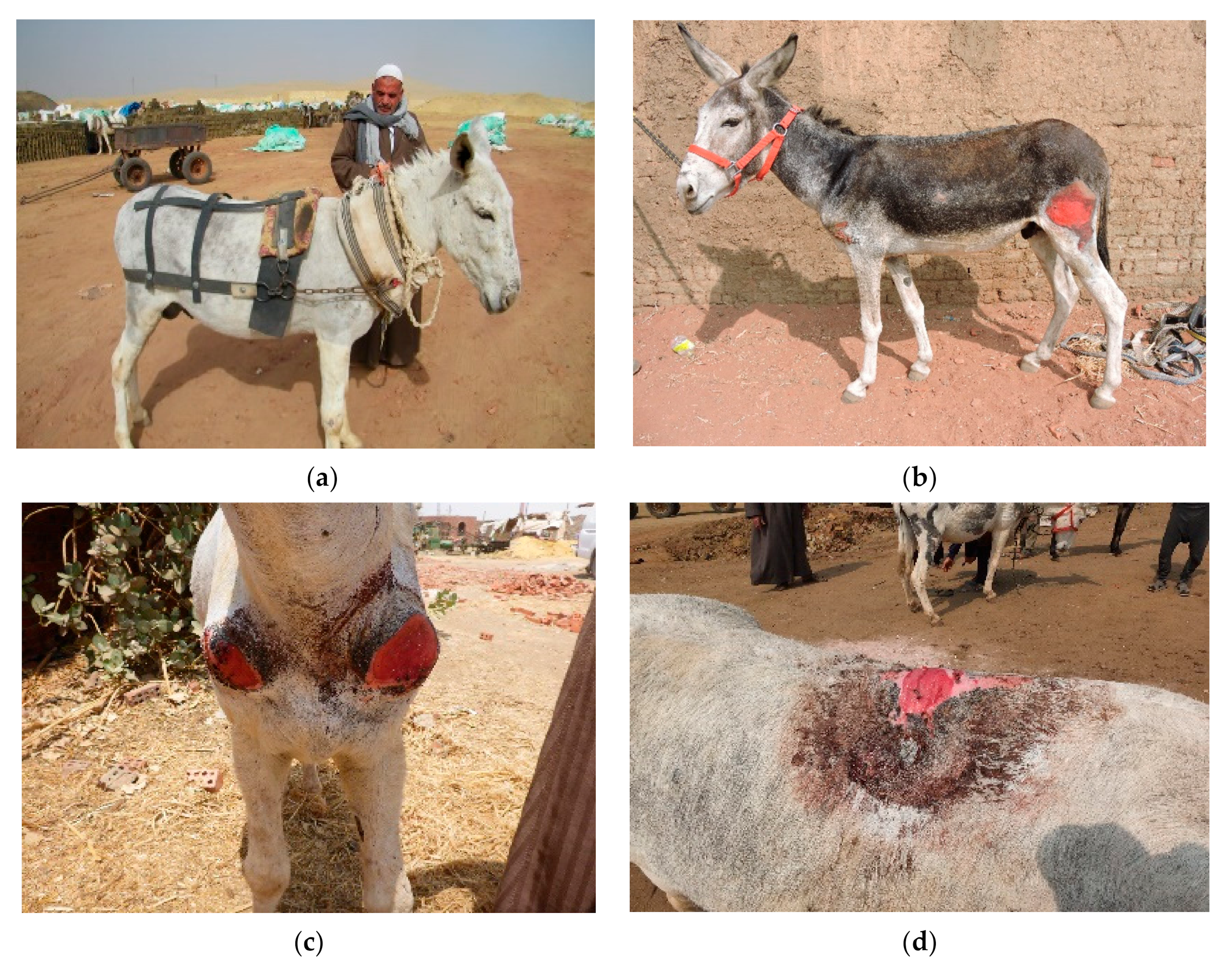

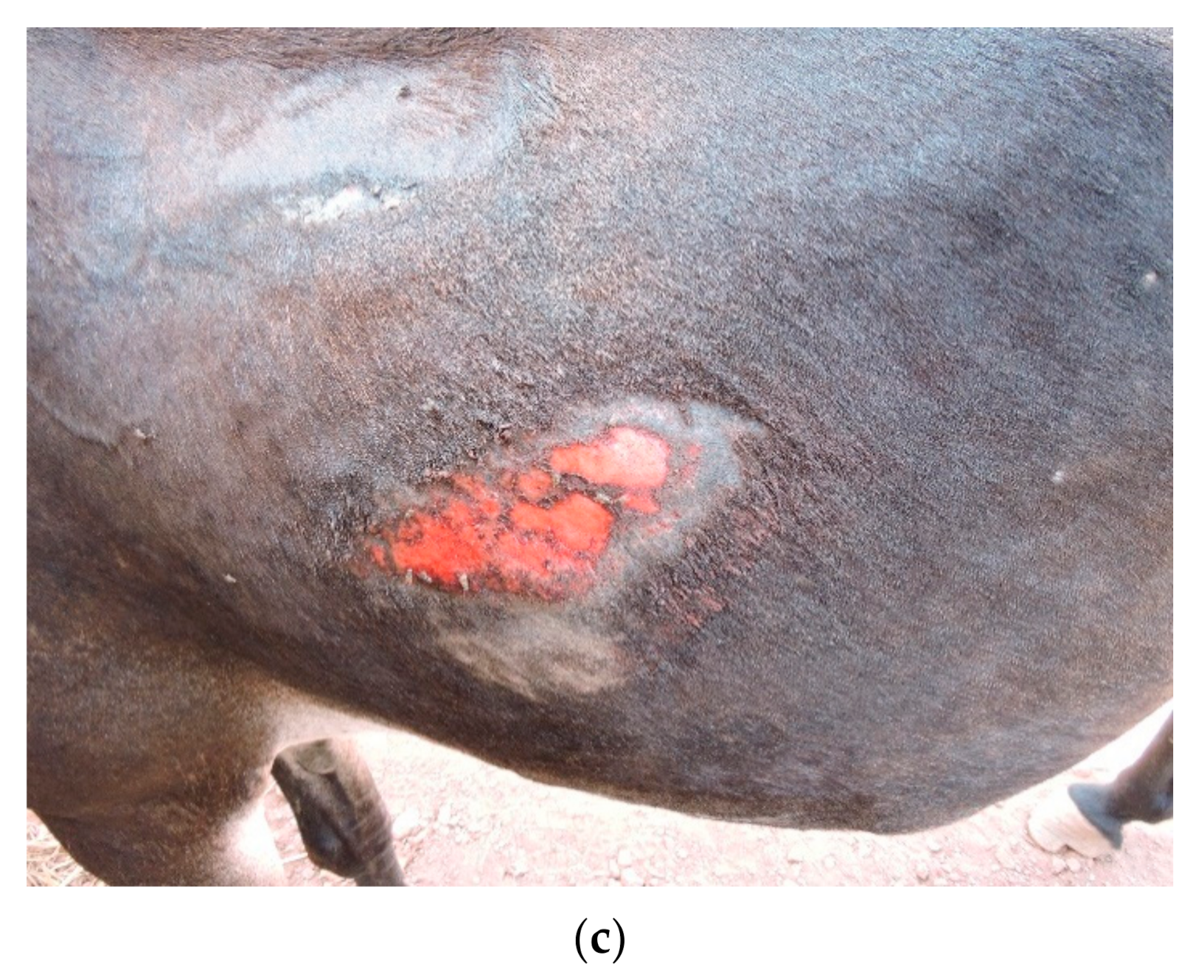
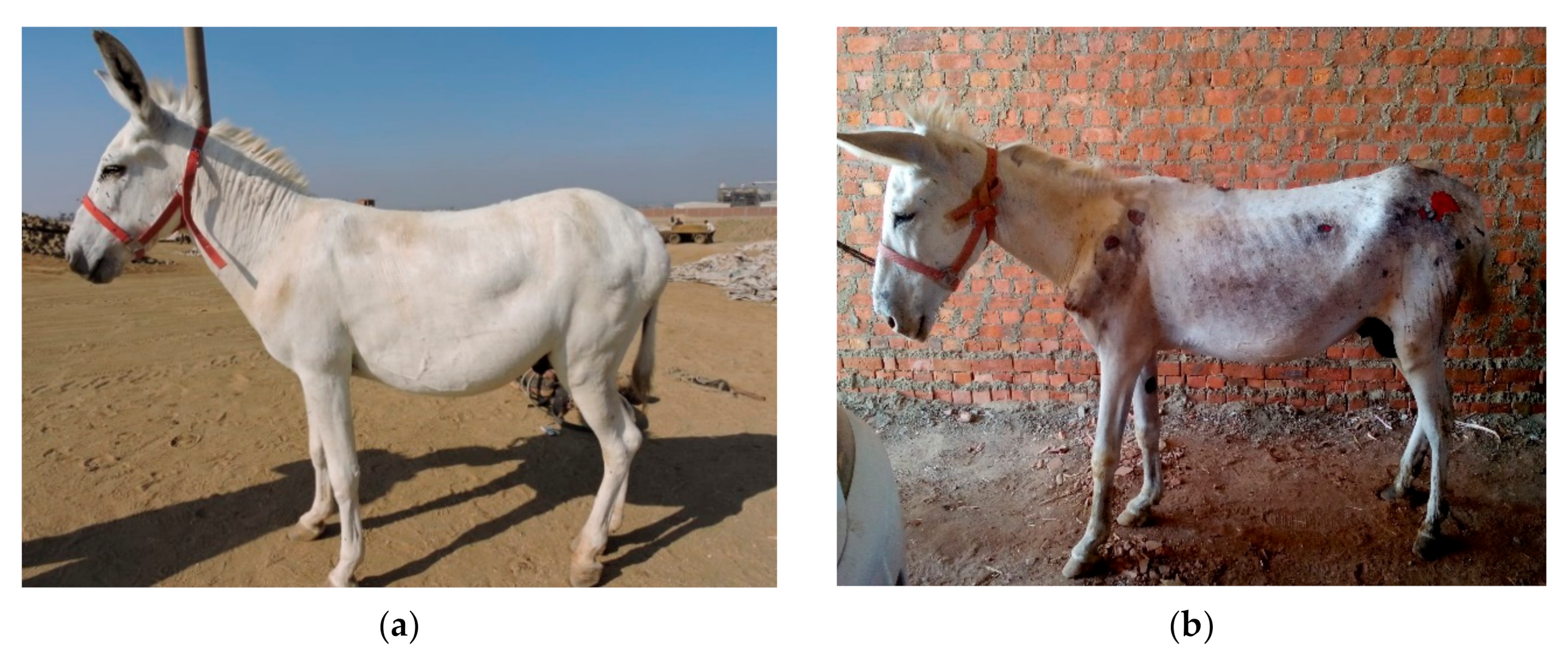
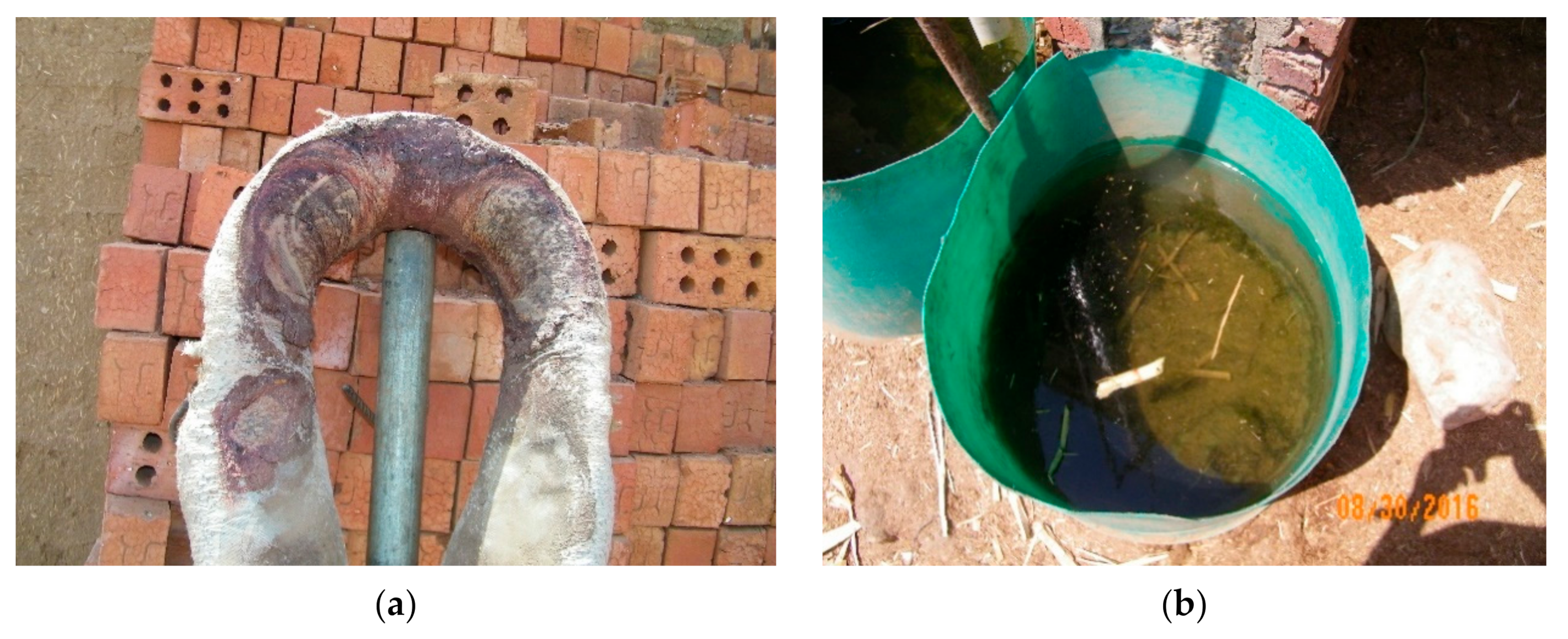
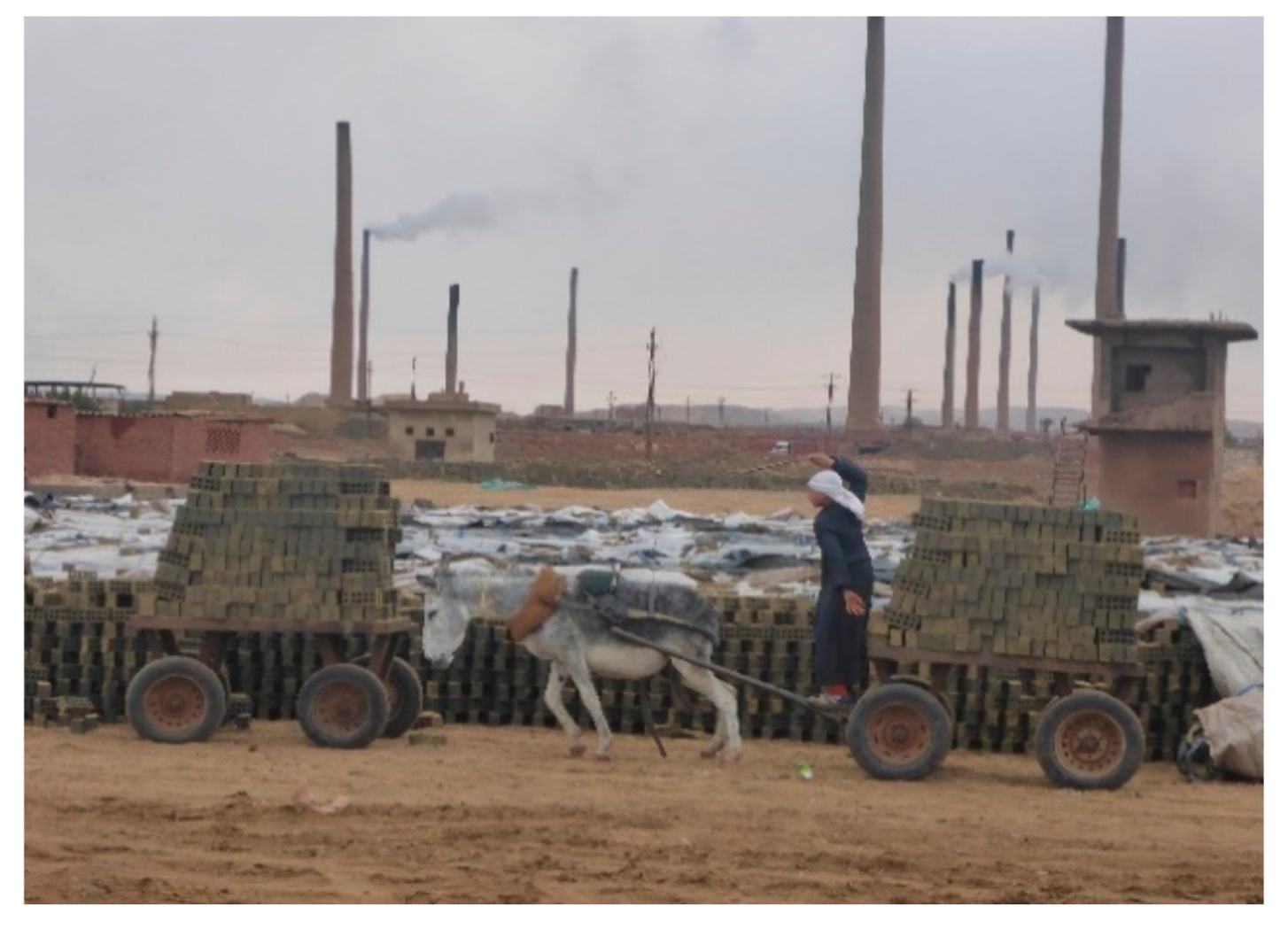
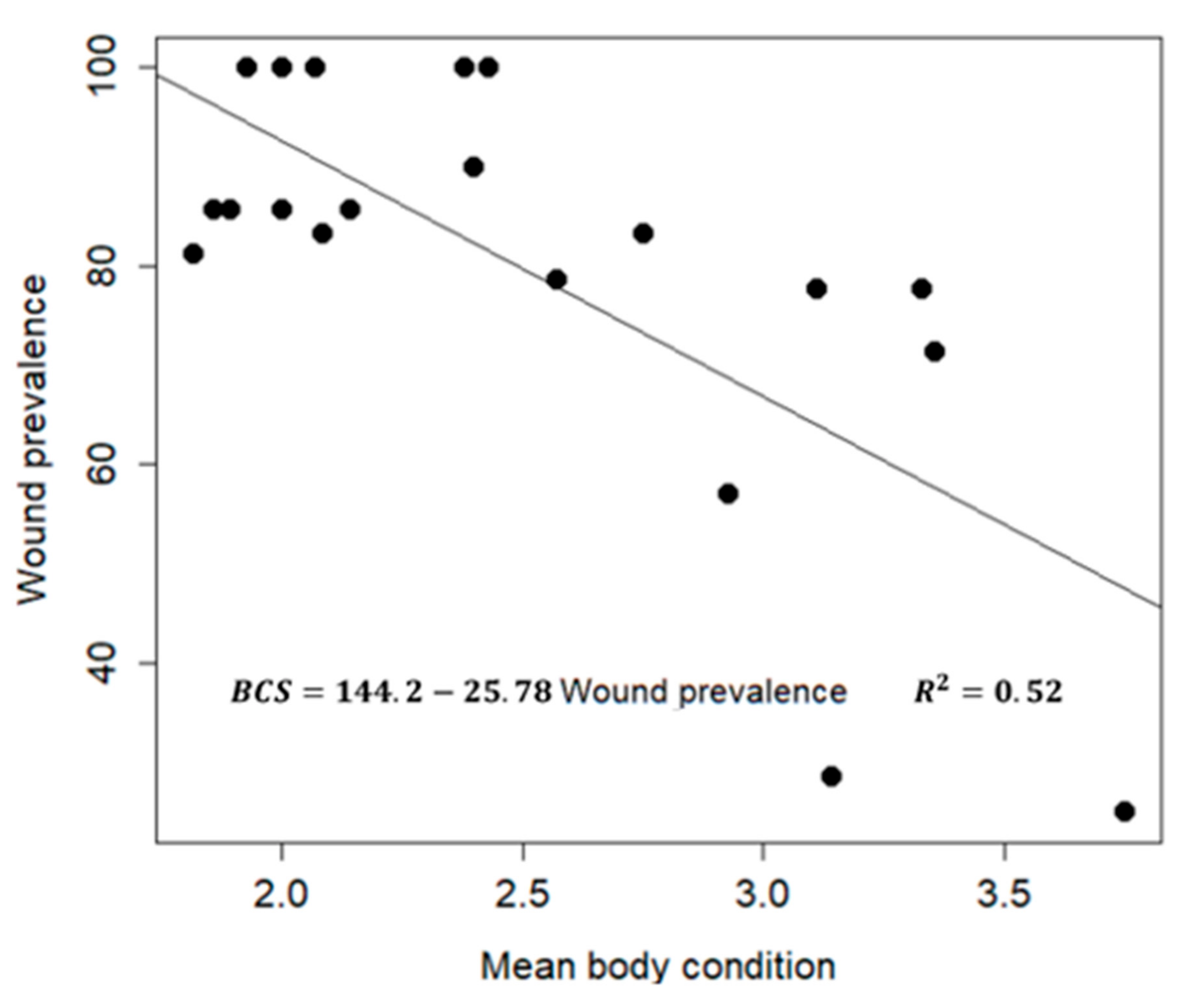

| Grade | Description |
|---|---|
| 1 = very bad | Poor contact surfaces due to excessive wear, broken parts, or bad construction (despite being new), and the use of non-equine-friendly materials, such as wire, plastics, and nylon, in areas that are in physical contact with the donkey |
| 2 = bad | Well used, but developing problems with contact surfaces |
| 3 = fair | Well used, but in a good condition and with good contact surfaces for the donkey |
| 4 = good | A harness level that falls between 3 and 5 |
| 5 = very good | Well made, not well used, with good contact surfaces for the donkey |
| Grade | Description |
|---|---|
| 1 = bad | Encrusted and dried on bodies (blood, mud, feces, etc.) and likely to cause injury |
| 2 = fair | Dusty, but not abrasive |
| 3 = good | Totally dirt free |
| Grade | Description |
|---|---|
| 1 = bad | Very poor, with no bearing left, and the shaft is narrow, causing injuries to donkeys’ sides. It may contain sharp objects, and the tires are deflated |
| 2 = fair | The wheel bearings have space to move from one side to the other, the shaft is tight, and the tires are not completely deflated, but the pressue inside is low |
| 3 = good | The wheel bearings have no space to move from side to side, the wheels easily rotate, the distance between the two shafts is wide enough to prevent injuries to the donkeys’ sides, and the tires are not deflated |
| Wound Type | Mean ± SE 1 | Median | Minimum | Maximum |
|---|---|---|---|---|
| Saddle | 25.86 ± 3.60 | 13.00 | 0.13 | 150.0 |
| Beating | 47.95 ± 6.26 | 30.00 | 1.75 | 365.5 |
| Limb | 35.5 ± 17.80 | 8.50 | 0.20 | 385.0 |
| Neck | 23.32 ± 4.75 | 7.50 | 0.25 | 197.5 |
| Breeching | 77.80 ± 40.3 | 19.10 | 0.80 | 625.0 |
| Shaft | 89.60 ± 31.2 | 16.80 | 0.30 | 577.0 |
| Parameter | Donkey Status | N (%) | Mean ± SE 1 | Test Value | p-Value |
|---|---|---|---|---|---|
| General attitude | Alert | 32 (18%) | 2.95 ± 0.14 a | F-value = 10.38 | <0.001 ** |
| Apathetic | 113 (63%) | 2.34 ± 0.07 b | |||
| Depressed | 34 (19%) | 2.14 ± 0.14 b | |||
| Reaction to observer | Discovering | 13 (7%) | 3.42 ± 0.14 a | F-value = 6.65 | <0.001 ** |
| Not moving | 44 (25%) | 2.46 ± 0.13 b | |||
| Avoiding | 43 (24%) | 2.35 ± 0.12 b | |||
| Running away | 13 (7%) | 2.35 ± 0.17 b | |||
| Being aggressive | 66 (37%) | 2.24 ± 0.09 b | |||
| Chin contact | Accepting | 64 (36%) | 2.68 ± 0.11 a | T-value = 3.24 | 0.002 ** |
| Not accepting | 115 (64%) | 2.27 ± 0.07 b |
| Parameter | Mean ± SE 1 | Median | Coef 2 | T-Value | p-Value |
|---|---|---|---|---|---|
| Working hours/day | 6.23 ± 0.19 | 6.0 | −0.32 | −2.75 | 0.016 * |
| Number of donkeys | 8.95 ± 0.60 | 7.5 | 0.22 | 4.20 | 0.001 ** |
| Distance | 54.70 ± 3.53 | 53.5 | −0.02 | −2.40 | 0.031 * |
| Concrete amount/donkey | 2.52 ± 0.20 | 2.15 | 0.48 | 4.85 | 0.000 ** |
© 2020 by the authors. Licensee MDPI, Basel, Switzerland. This article is an open access article distributed under the terms and conditions of the Creative Commons Attribution (CC BY) license (http://creativecommons.org/licenses/by/4.0/).
Share and Cite
Farhat, S.F.; McLean, A.K.; Mahmoud, H.F.F. Welfare Assessment and Identification of the Associated Risk Factors Compromising the Welfare of Working Donkeys (Equus asinus) in Egyptian Brick Kilns. Animals 2020, 10, 1611. https://doi.org/10.3390/ani10091611
Farhat SF, McLean AK, Mahmoud HFF. Welfare Assessment and Identification of the Associated Risk Factors Compromising the Welfare of Working Donkeys (Equus asinus) in Egyptian Brick Kilns. Animals. 2020; 10(9):1611. https://doi.org/10.3390/ani10091611
Chicago/Turabian StyleFarhat, Shaaban F., Amy K. McLean, and Hamdy F. F. Mahmoud. 2020. "Welfare Assessment and Identification of the Associated Risk Factors Compromising the Welfare of Working Donkeys (Equus asinus) in Egyptian Brick Kilns" Animals 10, no. 9: 1611. https://doi.org/10.3390/ani10091611
APA StyleFarhat, S. F., McLean, A. K., & Mahmoud, H. F. F. (2020). Welfare Assessment and Identification of the Associated Risk Factors Compromising the Welfare of Working Donkeys (Equus asinus) in Egyptian Brick Kilns. Animals, 10(9), 1611. https://doi.org/10.3390/ani10091611






